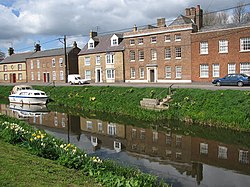Upwell
| Upwell | |
| Norfolk, Cambridgeshire | |
|---|---|
 Upwell showing the Well Creek and Town Street | |
| Location | |
| Grid reference: | TF500020 |
| Location: | 52°35’44"N, 0°12’48"E |
| Data | |
| Population: | 4,734 |
| Post town: | Wisbech |
| Postcode: | PE14 |
| Local Government | |
| Council: | King's Lynn and West Norfolk |
Upwell is a village and parish on the borders of Norfolk and Cambridgeshire. Upwell village is on the A1101 road, as is Outwell, its conjoined village at the north. The ancient parish additionally includes Welney, and all three lie across the county borders, formed here by the old course of the River Nene and the Old Croft River. The nearest towns are Wisbech to the north-west and Downham Market to the east.
The civil parish covers an area of 6,844 acres and had a population of 2,750 at the 2011 Census,[1] nearly doubling to 4,734 in the 2021 census.[2]
History
The villages name means 'higher well (= spring/stream)'. Originally, part of a single place called Well; 'upp' was appended to distinguish from Outwell.[3]
Upwell in 1202 had a market-place and a weekly market. Marmont Priory was endowed by Richard I with 300 acres in Upwell and Outwell. The priory of Gilbertines was founded in the reign of King John. Cultivation of flax and hemp is referred to in an order of Sessions of Sewers in 1340. Upwell was connected with Wisbech by a steam tramway in 1884[4]
William Wolsey a constable of Upwell, Outwell & Welney (and Robert Piggot of Wisbech) Protestants were tried at Ely for heresy and burnt at the stake in 1555.[5]
In 1810 a building was being used as a temporary theatre by Joseph Smedley at a cost of five Guineas. [6]
In 1869 Upwell St Peter, was the richest benefice of the English church, being returned in the clergy list as worth £3,058 a year, though worth considerably more, and had just become vacant by the death of the Rev. Wm Gale Townley, who had held it only seven years. The living was in the gift of Mr B. G. Townley. In the same parish is the rectory of Christ Church, returned as being worth £1,594 year, also belonging to the Townley family.[7]
Further reading
- Smith, William P (2021). The Ancient Town of Wella. Carillson Publications.
References
- ↑ "Civil Parish population 2011". http://www.neighbourhood.statistics.gov.uk/dissemination/LeadKeyFigures.do?a=7&b=11130026&c=Upwell&d=16&e=62&g=6449417&i=1001x1003x1032x1004&m=0&r=1&s=1440932514858&enc=1.
- ↑ "Upwell (Norfolk, East of England, United Kingdom) - Population Statistics, Charts, Map, Location, Weather and Web Information". https://www.citypopulation.de/en/uk/eastofengland/norfolk/E34004300__upwell/.
- ↑ "Key to English Place-names". http://kepn.nottingham.ac.uk/map/place/Norfolk/Upwell.
- ↑ F.J.Gardiner (1898). History of Wisbech and Neighbourhood. Gardiner & Co.
- ↑ G.M.G. Woodgate (1931). Wisbech in the Ely Episcopal Registers. The Isle of Ely and Wisbech Advertiser. p. 28.
- ↑ Neil R Wright (2016). Treading the Boards : Actors and theatres in Georgian Lincolnshire. SLHA. p. 69.
- ↑ "Upwell St Peter". Essex Herald: p. 7. 14 September 1869.
Outside links
| ("Wikimedia Commons" has material about Upwell) |